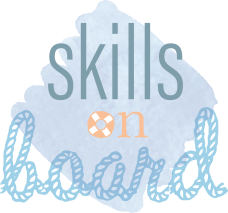6. Team Working
November 21, 20198. Keeping a positive attitude
November 21, 2019
Learning objectives
By the end of this module the skipper will be able to:
- Understand the meaning and importance of Work Ethics
- List the factors that affect his/her Ethical values and priorities
- Better understand how to sustain and/or improve their efforts in order to attain a higher, socially accepted Work Ethic.
How Can We Understand Ethics?
According to Velasquez, in simple terms, Ethics refers to standards of behaviour that tell us how human beings ought to act in the many situations in which they find themselves –as friends, parents, citizens, businesspeople, teachers, professionals, and so on.
Perhaps it helps to realize, for Business/Professional purposes, what the Work Ethic is not about. It is not only about religion, or following the laws, or succumbing to our feelings, or obeying to social norms. Ethics is not even a science, despite the fact there are scientific approaches and explanations that help us understand Ethics. So, if it is not about the above, how does one reach an appropriately “Good” Work Ethic standard? One fair generic advice is “Our Actions Must Match our Ambitions” —that is, our decisions and actions in the workplace must be consistent with our general plan and trajectory in life. There are several theoretical approaches to this end.
The Utilitarian Approach: The ethical corporate action is the one that produces the greatest good and does the least harm for all who are affected — customers, employees, shareholders, the community, and the environment.
The Rights Approach: The ethical action is the one that best protects and respects the moral rights of those affected. Also, it is often said that rights imply duties — in particular, the duty to respect others’ rights.
The Fairness or Justice Approach: Based on Aristotle, this approach claims that ethical actions treat all human beings equally –or if unequally, then fairly based on some standard that is defensible.
The Common Good Approach: This approach suggests that the interlocking relationships of society are the basis of ethical reasoning and that respect and compassion for all others — especially the vulnerable — are requirements of such reasoning. This approach also calls attention to the common conditions that are important to the welfare of everyone.
The Virtue Approach: Ethical actions ought to be consistent with certain ideal virtues that provide for the full development of our humanity. Truth and beauty, honesty, courage, compassion, generosity, tolerance, love, fidelity, integrity, fairness, self-control, and prudence are all examples of virtues.
Even if we do not all agree on the same sets of values implied by each approach, bringing the approaches together and asking ourselves basic questions about each situation that presents us with a so-called ethical dilemma can be very facilitating in reaching a decision. For example, we can evaluate the options available by asking the following questions: Evaluate the options by asking the following questions:
- Which option will produce the most good and do the least harm? (The Utilitarian Approach)
- Which option best respects the rights of all who have a stake? (The Rights Approach)
- Which option treats people equally or proportionately? (The Justice Approach)
- Which option best serves the community as a whole, not just some members? (The Common Good Approach)
- Which option leads me to act as the sort of person I want to be? (The Virtue Approach)
In more practical terms, one needs to be prepared for tackling such ethical dilemmas by following a simple set of rules on their everyday workplace reality. Erskine (2013) has nicely summarized these as follows:
- Practice punctuality. Develop the habit of being on time or early for all appointments. Use time “Never leave that ‘till tomorrow which you can do today” and “Time is money.” It’s age-old advice, but far from outdated. Time management is dealt with in detail separately in this Training; make sure you study that module.
- Develop professionalism. Professionalism goes beyond wearing clean clothes and being polite to others. It includes your attitude, values, and demeanour. Being positive, honest, respectful of everyone and cordial –all work towards what is often described as our personal branding, very close to our personal reputation and the value others see in us when they describe us.
- Cultivate self-discipline. Train yourself to be persistent and to follow through on projects. Strive for excellence in your assignments.
- Stay balanced. Taking care of yourself properly permits you the clarity required to take care of your colleagues, your crew and your customers. Get proper sleep. Eat right. Take time to relax and recharge. Keeping your priorities in life clear helps you maintain the proper perspective at work.
Special Note on Corporate Rules of Conduct
It is important to realize that being employed by large corporations present individuals with higher challenges, especially when dealing directly with customers. Corporations are very particular about their reputation and always take advance measures in ensuring their employees’ behaviour is consistent and compliant with their sets of their Code of Conduct and Work Ethics. In such cases, personal decisions on the spot are always subject to following company regulations or instructions. A very good example comes from Carnival Corp., (with subsidiaries such as Cunard, Princess Cruises, P&O Cruises and Holland America Line). The company trains all employees and ensures that everyone understands the importance of procedure and compliance. The fact that this is a very large corporation with thousands of employees does not, in reality, make this a different case. Priorities are (and should be) the same for the sole Skipper or a small-sized cruise company. Namely,
- Maintaining positive, safe and healthy workplaces [commitment to colleagues]
- Providing integral, dependable, high-quality services [commitment to customers]
- Avoiding conflicts of interest and financial mismanagement, safeguarding resources and information, protecting the reputation and resolving improper conduct [commitment to company and shareholders]
- Building healthy relationships with partners [commitment to business partners]
- Protecting the Environment, supporting Human Rights, promoting Sustainability [commitment to Society]
Implicitly, any Code of Conduct and Work Ethics refers to the same basic, universal set of rules which regulate human behaviour across the Globe.
A short VIDEO to appreciate what is included in “Work Ethics”
Time for a short TEST!
References
Velasquez, M. et al. (2015) “A Framework for Thinking Ethically”, Markkula Center for Applied Ethics, Santa Clara University. https://www.scu.edu/ethics/ethics-resources/ethical-decision-making/thinking-ethically/
Erskine, M. B. (2013) “Work Ethic: 5 Easy Steps for Developing a Good Work Ethic”, Saint Leo University, USA. https://www.saintleo.edu/blog/how-to-develop-a-good-work-ethic-in-5-easy-steps
Carnival Corp. & PLC (2015) Code of Business Conduct and Ethics, corporate publication PDF. Downloaded from http://phx.corporate-ir.net/phoenix.zhtml?c=140690&p=irol-govconduct
The Ethics Guy (Dr. Bruce Weinstein) on CNN news, 7 May 2009, “How Ethical Are You?” https://youtu.be/Lhwhgf01Ozw





